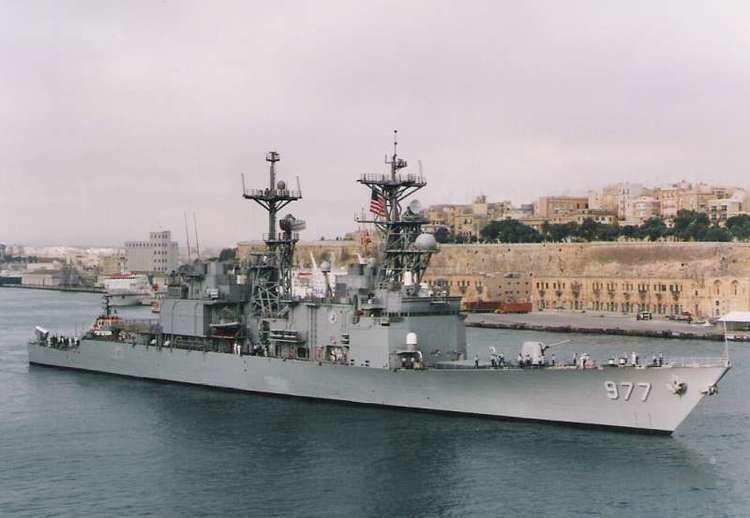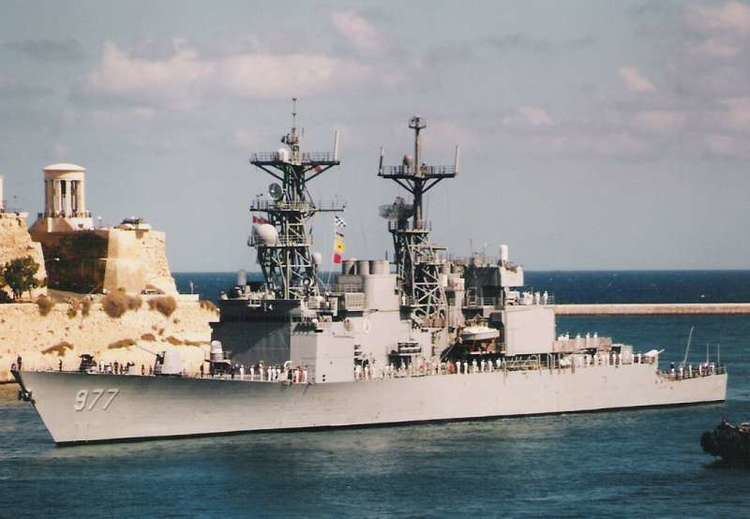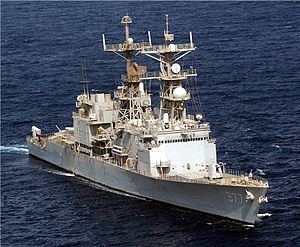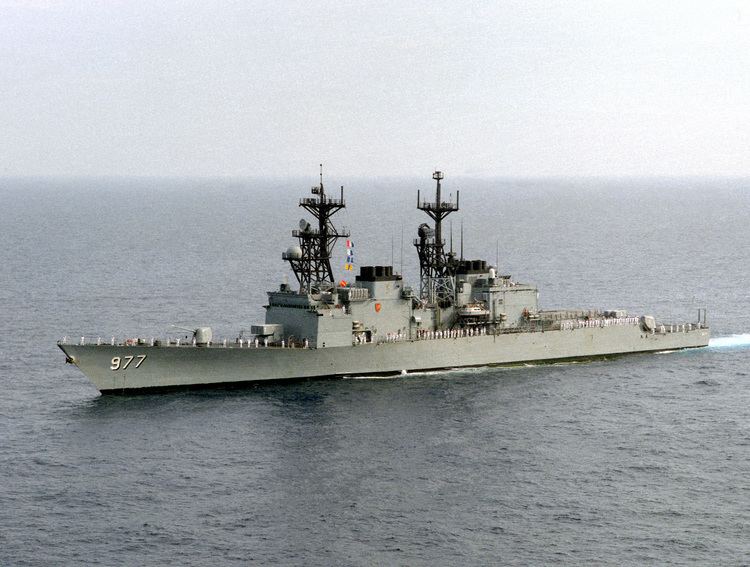Laid down 21 July 1975 Commissioned 3 June 1978 Construction started 21 July 1975 Draft 8.84 m | Ordered 26 January 1972 Acquired 8 May 1978 Decommissioned 2 October 2003 Launched 28 December 1976 Beam 17 m | |
USS Briscoe (DD-977), named for Admiral Robert Pearce Briscoe USN, was a Spruance-class destroyer built by the Ingalls Shipbuilding Division of Litton Industries at Pascagoula, Mississippi. She was laid down 21 July 1975, launched 28 December 1976 and commissioned 3 June 1978. The ship operated out of Norfolk, Virginia during her entire 25-year career. When decommissioned, she was part of Destroyer Squadron 22.
Contents

History

Briscoe conducted firing trials in 1981-1982 in support of the SALGP (Semi-Active Laser Guided Projectile) off the coast of Vieques, Puerto Rico. These projectiles were fired from the 5 inch (127 mm) gun at a range in excess of 11 miles (18 km). While in flight, an optical sensor would detect the signature of a laser-painted target on shore and convert the shell to an actively homing rocket for pinpoint destruction of moving and stationary targets on shore.

Participated in Operation Urgent Fury, the liberation of Grenada, and in the Multi-National Peacekeeping Forces off the coast of Lebanon, and in Baltic Operations 1990. Briscoe also participated as a member of Middle East Forces deploying twice to the North Red Sea conducting Maritime Interception Operations in support of U.N. sanctions against Iraq. Briscoe established a U.S. record of 275 merchant vessel boardings in the North Red Sea during the first of her two deployments to the area.

In her second North Red Sea deployment in March 1994, Briscoe responded to a distress call from an Egyptian passenger ferry, the Al-Qamar Al-Saudi Al-Misri. Briscoe acted as the On-Scene Commander for the ensuing rescue efforts for the over 500 passengers, coordinating the actions of the numerous vessels in the area.
In 1996, Briscoe deployed to the Mediterranean and Black Sea for a six-month period. Deployed with Helicopter Antisubmarine Squadron Light 44 (Detachment 5), Briscoe in Exercise Atlas Hinge with the Tunisian navy and Exercise Shark Hunt and Jaws, an undersea warfare exercise against U.S. submarines in the Central and Eastern Mediterranean Sea.
Briscoe took part in Exercise Classica 96, from 31 August through 9 September, in the spirit of Partnership for Peace. Ships from the U.S. 6th Fleet, Black Sea and Mediterranean littoral nations (including Italy, Ukraine, Greece.
In 1999, at President Bill Clinton's orders, warships of the U.S. Navy assisted in the search for the crashed plane of John F. Kennedy Jr.. With the permission of Secretary of Defense William Cohen, a public memorial service for Kennedy was later held aboard the Briscoe and his ashes were scattered from this ship and into the Atlantic Ocean off the coast of Martha's Vineyard.
Routine deployment workups were interrupted in 2001, as Briscoe responded to help provide aerial defense of the U.S. East Coast after the terrorist attacks, Sept. 11, 2001. In December 2002, Briscoe deployed as part of the Harry S. Truman Battle Group in support of Operation Iraqi Freedom. Briscoe was one of the first ships to fire Tomahawk cruise missiles on targets in Iraq, firing in total 25 missiles.
Briscoe was decommissioned 2 October 2003. She was disposed of in support of a fleet training exercise on 25 August 2005. She lies at 34°49’N – 72°31’W at a depth of 2,252 fathoms.
Ship's crest
The ship's coat of arms is a reflection of the distinguished naval career of Admiral Robert Pearce Briscoe.
Standing boldly at the base of the shield is the Lion of St. Mark, which refers to the Admiral's leadership as Commander in Chief of Allied Southern Forces Europe. The fess and wavy bar, immediately above the Lion of St. Mark, suggest flowing water passing warships and small land areas. This is reminiscent of the Northern Solomon Islands where Admiral Briscoe commanded the USS Denver in World War II several important engagements. The shield is completed by four stars, symbolic of Admiral Briscoe's leadership achievement and rank.
Atop the shield is a crest symbolic of further achievement in a long and successful career. The trident, symbol of Triton, ruler of the seas, refers to the United States Naval Academy where the Admiral served as a student, instructor and department head. The flash represents Prometheus' gift of science to mankind and alludes to Admiral Briscoe as one of the pioneers of modern electronics development in the Navy. The cross refers to the Navy Cross Admiral Briscoe received for his actions in the North Solomon Campaign. The crest is completed by the Taegeuk which denotes the Admiral's Far East Naval Command.
The entire coat of arms is aptly summed up by the ship's motto "Efficiency and Valor", given to the ship by former Chief of Naval Operations, Admiral Robert Carney, as a tribute to his close friend.
